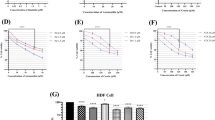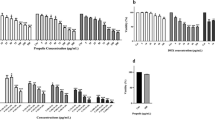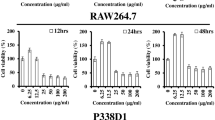Abstract
Background
In spite of the great progress in acute lymphoblastic leukemia (ALL) treatment, a large number of patients still suffer from chemotherapy drug toxicity. As a routine medication for ALL treatment, cytarabine (Ara-C) has many side effects on the patients. Astaxanthin (ASX), on the other hand, is a carotenoid with antioxidant, anti-inflammatory and anti-cancer properties.
Purpose
The present study investigated the effects of ASX in combination with Ara-C on cell proliferation, apoptosis induction, and cell cycle arrest in NALM-6 cell line.
Methods
NALM6 cells were treated with different concentrations of ASX, Ara-C, and their co-treatment. Cytotoxic effects were evaluated using MTT assay. After treating the cells with the IC50 dose of ASX, Ara-C and their co-treatment, we studied apoptosis induction, cell cycle arrest, and expression of apoptotic, anti-apoptotic, and inflammatory genes.
Result
MTT assay demonstrated that co-treatment of cytarabine and ASX had greater cytotoxicity effects compared with the IC50 dose of Ara-C alone. After 48 h of treatment of NALM-6 cells with the combination dose, expression levels of apoptotic genes (P53, caspase-8, 3), the anti-apoptotic gene (Bcl-xL) and inflammatory genes (IL-6, TNF-α) changed significantly compared to the untreated group (p < 0.05).
Conclusions
Co-treatment of ASX and Ara-C has synergism effects on apoptosis pathways, cell proliferation inhibition, and decreased inflammation.



Similar content being viewed by others
Data availability
Not applicable.
Abbreviations
- ALL:
-
Acute lymphoblastic leukemia
- Ara-C:
-
Arabinosyl cytosine
- ASX:
-
Astaxanthin
- Caspase:
-
Cysteine-aspartic acid protease
- TNF-α:
-
Tumor necrosis factor- α
- IL-6:
-
Interleukin-6
- Bcl-xL:
-
B-cell lymphoma-extra-large
- DMSO:
-
Dimethyl sulfoxide
References
Rehman A, Abbas N, Saba T, Rahman SIU, Mehmood Z, Kolivand H (2018) Classification of acute lymphoblastic leukemia using deep learning. Microsc Res Tech 81:1310–1317. https://doi.org/10.1002/jemt.23139
Haso W, Lee DW, Shah NN, Stetler-Stevenson M, Yuan CM, Pastan IH, Dimitrov DS, Morgan RA, FitzGerald DJ, Barrett DM (2013) Anti-CD22–chimeric antigen receptors targeting B-cell precursor acute lymphoblastic leukemia. Blood J Am Soc Hematol 121:1165–1174. https://doi.org/10.1182/blood-2012-06-438002
Faruqi A, Tadi P (2020) Cytarabine. https://www.ncbi.nlm.nih.gov/books/NBK557680/.
Baker WJ, Royer GL Jr, Weiss RB (1991) Cytarabine and neurologic toxicity. J Clin Oncol 9:679–693. https://doi.org/10.1200/JCO.1991.9.4.679
Ganesan P, Noda K, Manabe Y, Ohkubo T, Tanaka Y, Maoka T, Sugawara T, Hirata T (2011) Siphonaxanthin, a marine carotenoid from green algae, effectively induces apoptosis in human leukemia (HL-60) cells. Biochim Biophys Acta 1810:497–503. https://doi.org/10.1016/j.bbagen.2011.02.008
Zhang L, Wang H (2015) Multiple mechanisms of anti-cancer effects exerted by astaxanthin. Mar Drugs 13:4310–4330. https://doi.org/10.3390/md13074310
Zhang X, Zhao W-E, Hu L, Zhao L, Huang J (2011) Carotenoids inhibit proliferation and regulate expression of peroxisome proliferators-activated receptor gamma (PPARγ) in K562 cancer cells. Arch Biochem Biophys 512:96–106. https://doi.org/10.1016/j.abb.2011.05.004
Choi C-I (2019) Astaxanthin as a peroxisome proliferator-activated receptor (PPAR) modulator: Its therapeutic implications. Mar Drugs 17:242. https://doi.org/10.3390/md17040242
Khomlaem C, Aloui H, Oh W-G, Kim BS (2021) High cell density culture of Paracoccus sp. LL1 in membrane bioreactor for enhanced co-production of polyhydroxyalkanoates and astaxanthin. Int J Biol Macromol 192:289–297. https://doi.org/10.1016/j.ijbiomac.2021.09.180
Liu C, Tan Y, Xu Y, McCleiments DJ, Wang D (2019) Formation, characterization, and application of chitosan/pectin-stabilized multilayer emulsions as astaxanthin delivery systems. Int J Biol Macromol 140:985–997. https://doi.org/10.1016/j.ijbiomac.2019.08.071
Chintong S, Phatvej W, Rerk-Am U, Waiprib Y, Klaypradit W (2019) In vitro antioxidant, antityrosinase, and cytotoxic activities of astaxanthin from shrimp waste. Antioxidants 8:128. https://doi.org/10.3390/antiox8050128
McCall B, McPartland CK, Moore R, Frank-Kamenetskii A, Booth BW (2018) Effects of astaxanthin on the proliferation and migration of breast cancer cells in vitro. Antioxidants 7:135. https://doi.org/10.3390/antiox7100135
Wayakanon K, Rueangyotchanthana K, Wayakanon P, Suwannachart C (2018) The inhibition of Caco-2 proliferation by astaxanthin from Xanthophyllomyces dendrorhous. J Med Microbiol 67:507–513. https://doi.org/10.1099/jmm.0.000710
Atalay PB, Kuku G, Tuna BG (2019) Effects of carbendazim and astaxanthin co-treatment on the proliferation of MCF-7 breast cancer cells. In Vitro Cell Dev Biol Anim 55:113–119. https://doi.org/10.1007/s11626-018-0312-0
Yan T, Li HY, Wu JS, Niu Q, Duan WH, Han QZ, Ji WM, Zhang T, Lv W (2017) Astaxanthin inhibits gemcitabine-resistant human pancreatic cancer progression through EMT inhibition and gemcitabine resensitization. Oncol Lett 14:5400–5408. https://doi.org/10.3892/ol.2017.6836
Johnston D, Lewis V, Yanofsky R, Gillmeister B, Ethier M, Mitchell D, Cellot S, Dix D, Portwine C, Price V (2013) Invasive fungal infections in paediatric acute myeloid leukaemia. Mycoses 56:482–487. https://doi.org/10.1111/myc.12063
Flora SD, Ferguson LR (2005) Overview of mechanisms of cancer chemopreventive agents. Mutat Res 591(1–2):8–15. https://doi.org/10.1016/j.mrfmmm.2005.02.029
Kheirandish S, Rastgar A, Hamidi M, Sajjadi SM, Anani Sarab G (2022) Evaluation of anti-tumor effect of the exopolysaccharide from new cold-adapted yeast, Rhodotorula mucilaginosa sp. GUMS16 on chronic myeloid leukemia K562 cell line. Int J Biol Macromol 206:21–28. https://doi.org/10.1016/j.ijbiomac.2022.02.113
de la Maza Cantero SS, Martín AJ, de Felipe Mimbrera A, Corral ÍC (2016) Cerebellar toxicity due to cytarabine: a series of 4 cases. Neurologia 7:491–492. https://doi.org/10.1016/j.nrl.2014.12.017
Lavriv DS, Neves PM, Ravasco P (2018) Should omega-3 fatty acids be used for adjuvant treatment of cancer cachexia? Clin Nutr ESPEN 25:18–25. https://doi.org/10.1016/j.clnesp.2018.02.006
Morland SL, Martins KJ, Mazurak VC (2016) n-3 polyunsaturated fatty acid supplementation during cancer chemotherapy. J Nutr Intermed Metab 5:107–116. https://doi.org/10.1016/j.jnim.2016.05.001
Abou-Zeid SM, Aljuaydi SH, AbuBakr HO, Tahoun EA, Di Cerbo A, Alagawany M, Khalil SR, Farag MR (2021) Astaxanthin mitigates thiacloprid-induced liver injury and immunotoxicity in male rats. Marine drugs 19(9):525. https://doi.org/10.3390/md19090525
Kanno S-I, Higurashi A, Watanabe Y, Shouji A, Asou K, Ishikawa M (2004) Susceptibility to cytosine arabinoside (Ara-C)-induced cytotoxicity in human leukemia cell lines. Toxicol Lett 152:149–158. https://doi.org/10.1016/j.toxlet.2004.04.014
Zhao H, Gu H, Zhang H, Li J-H, Zhao W-E (2014) PPARγ-dependent pathway in the growth-inhibitory effects of K562 cells by carotenoids in combination with rosiglitazone. Biochim Biophys Acta 1840:545–555. https://doi.org/10.1016/j.bbagen.2013.09.005
Gómez AM, Martínez C, González M, Luque A, Melen GJ, Martínez J, Hortelano S, Lassaletta Á, Madero L, Ramírez M (2015) Chemokines and relapses in childhood acute lymphoblastic leukemia: a role in migration and in resistance to antileukemic drugs. Blood Cells Mol Dis 55:220–227. https://doi.org/10.1016/j.bcmd.2015.07.001
Messina CM, Manuguerra S, Renda G, Santulli A (2019) Biotechnological applications for the sustainable use of marine by-products: in vitro antioxidant and pro-apoptotic effects of astaxanthin extracted with supercritical CO 2 from parapeneus longirostris. Mar Biotechnol 21:565–576. https://doi.org/10.1007/s10126-019-09904-y
El-Subbagh HI, Al-Badr AA (2009) Chapter 2 Cytarabine. Profiles Drug Subst Excip Relat Methodol. https://doi.org/10.1016/S1871-5125(09)34002-9
Liu X, Song M, Gao Z, Cai X, Dixon W, Chen X, Cao Y, Xiao H (2016) Stereoisomers of astaxanthin inhibit human colon cancer cell growth by inducing G2/M cell cycle arrest and apoptosis. J Agric Food Chem 64:7750–7759. https://doi.org/10.1021/acs.jafc.6b03636
Song X, Wang M, Zhang L, Zhang J, Wang X, Liu W, Gu X, Lv C (2012) Changes in cell ultrastructure and inhibition of JAK1/STAT3 signaling pathway in CBRH-7919 cells with astaxanthin. Toxicol Mech Methods 22:679–686. https://doi.org/10.3109/15376516.2012.717119
Kishimoto Y, Tani M, Uto-Kondo H, Iizuka M, Saita E, Sone H, Kurata H, Kondo K (2010) Astaxanthin suppresses scavenger receptor expression and matrix metalloproteinase activity in macrophages. Eur J Nutr 49:119–126. https://doi.org/10.1007/s00394-009-0056-4
Kim JH, Park J-J, Lee BJ, Joo MK, Chun HJ, Lee SW, Bak Y-T (2016) Astaxanthin inhibits proliferation of human gastric cancer cell lines by interrupting cell cycle progression. Gut liver 10:369. https://doi.org/10.5009/gnl15208
Faraone I, Sinisgalli C, Ostuni A, Armentano M, Carmosino M, Miella L et al (2020) Astaxanthin anticancer effects are mediated through multiple molecular mechanisms: a systematic review. Pharmacol Res 155:104689. https://doi.org/10.1016/j.phrs.2020.104689
Acknowledgements
We would like to thank BUMS core research laboratory for providing the facilities for conducting this research.
Funding
Not applicable.
Author information
Authors and Affiliations
Contributions
AR: Carried out the experiments, wrote the manuscript, and did data analysis. MS (co-first author): designed the study, carried out the experiments, wrote the manuscript, and did data analysis. GAS: Edited the manuscript and did data interpretation. SMS: designed the study, supervised the project, and revised the manuscript.
Corresponding author
Ethics declarations
Conflict of interest
The authors stated no conflict of interest.
Research involving Human Participants and/or Animals
Not applicable.
Informed consent
Not applicable.
Consent to participate
Not applicable.
Consent for publication
Not applicable.
Additional information
Publisher's Note
Springer Nature remains neutral with regard to jurisdictional claims in published maps and institutional affiliations.
Mahtab Sayadi contributed equally to this work as the first author.
Rights and permissions
About this article
Cite this article
Rastgar, A., Sayadi, M., Anani-Sarab, G. et al. Astaxanthin decreases the growth-inhibitory dose of cytarabine and inflammatory response in the acute lymphoblastic leukemia cell line NALM-6. Mol Biol Rep 49, 6415–6422 (2022). https://doi.org/10.1007/s11033-022-07452-8
Received:
Accepted:
Published:
Issue Date:
DOI: https://doi.org/10.1007/s11033-022-07452-8




